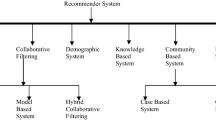Abstract
We describe a personalized recommender system designed to suggest new products to supermarket shoppers. The recommender functions in a pervasive computing environment, namely, a remote shopping system in which supermarket customers use Personal Digital Assistants (PDAs) to compose and transmit their orders to the store, which assembles them for subsequent pickup. The recommender is meant to provide an alternative source of new ideas for customers who now visit the store less frequently. Recommendations are generated by matching products to customers based on the expected appeal of the product and the previous spending of the customer. Associations mining in the product domain is used to determine relationships among product classes for use in characterizing the appeal of individual products. Clustering in the customer domain is used to identify groups of shoppers with similar spending histories. Cluster-specific lists of popular products are then used as input to the matching process.
The recommender is currently being used in a pilot program with several hundred customers. Analysis of results to date have shown a 1.8% boost in program revenue as a result of purchases made directly from the list of recommended products. A substantial fraction of the accepted recommendations are from product classes new to the customer, indicating a degree of willingness to expand beyond present purchase patterns in response to reasonable suggestions.
Similar content being viewed by others
References
Agrawal, R. and Srikant, R. 1994. Fast algorithms for mining association rules. In Proc. of the 20th Int'l Conference on Very Large Databases, Santiago, Chile, Sept. 1994.`
Aggarwal, C.C., Wolf, J.L., Wu, K-L., and Yu, P.S. 1999. Horting hatches an egg: A new graph-theoretic approach to collaborative filtering. In KDD-99 Proceedings, pp. 201–212.
Almasi, G.S. and Lee, A.J. 2000. A PDA-based personalized recommender agent. In Proc. Fifth International Conf. on the Practical Application of Intelligent Agent and Multi Agent Technology, Manchester, England, pp. 299–309, April 2000.
Balabanovic, M. and Shoham, Y. 1997. Fab: Content-based, collaborative recommendation. Communications of the ACM, 40(3):66–72.
Bezdek, J.C. and Pal, N.R. 1998. Some new indexes of cluster validity. IEEE Transactions on Systems, Man, and Cybernetics—Part B: Cybernetics, 28(3):301–315.
Borchers, A., Herlocker, J., Konstan, J., and Riedl, J. 1998. Ganging up on information overload. Computer, 31(4):106-108.
Everitt, B.S. 1993. Cluster Analysis, London: Edward Arnold. First Annual Personalization Summit. 1999. www.personalization.com, San Francisco, Nov. 15- 16, 1999. Intelligent Miner for Data. www.ibm.com/software/data/iminer/fordata.
Kohonen, T. 1995. Self-Organizing Maps. Springer-Verlag.
Konstan, J., Miller, B., Maltz, D., Herlocker, J., Gordon, L.R., and Riedl, J. 1997. GroupLens: Applying collaborative filtering to usenet news. Communications of ACM, 40(3).
Kotlyar V., Viveros, M.S., Duri, S.S., Lawrence, R.D., and Almasi, G.S. 1999. Acase study in information delivery to mass retail markets. In Proceedings of the 10th International Conference on Database and Expert Systems Applications (DEXA), Florence, Italy, Aug./Sept. 1999, Springer-Verlag. Lecture Notes in Computer Science, vol. 1677.
Lawrence, R.D., Almasi, G.S., and Rushmeier, H.E. 1999. A scalable parallel algorithm for self-organizing maps with applications to sparse data mining problems. Data Mining and Knowledge Discovery, 3:171–195.
Michaud, P. 1999. Clustering techniques. Future Generation Computer Systems, 13(2). 32 LAWRENCE ET AL.
Resnick, P. and Varian, H.R. 1997. Recommender systems. Communications of the ACM, 40(3):56–58. Also see other articles in this special issue.
Robbins, H. and Van Ryzin, J. 1975. Introduction to Statistics. Scientific Research Associates, Inc.
Salton, J. 1989. Automatic Text Processing: The Transformation, Analysis and Retrieval of Information By Computer. Reading, MA: Addison-Wesley.
Salton, J. and McGill, M.J. 1983. Introduction to Modern Information Retrieval. New York: McGraw-Hill.
Shardanand, U. and Maes, P. 1995. Social information filtering: Algorithms for automating word of mouth. In Proc. CHI 95, ACM Press, pp. 202–209.
Ungar, L.H. and Foster, D.P. 1998. Clustering methods for collaborative filtering. In Proceedings of 1998 AAAI Workshop on Recommender Systems. Available as AAAI Technical Report WS-98-08.
Author information
Authors and Affiliations
Rights and permissions
About this article
Cite this article
Lawrence, R., Almasi, G., Kotlyar, V. et al. Personalization of Supermarket Product Recommendations. Data Mining and Knowledge Discovery 5, 11–32 (2001). https://doi.org/10.1023/A:1009835726774
Issue Date:
DOI: https://doi.org/10.1023/A:1009835726774




